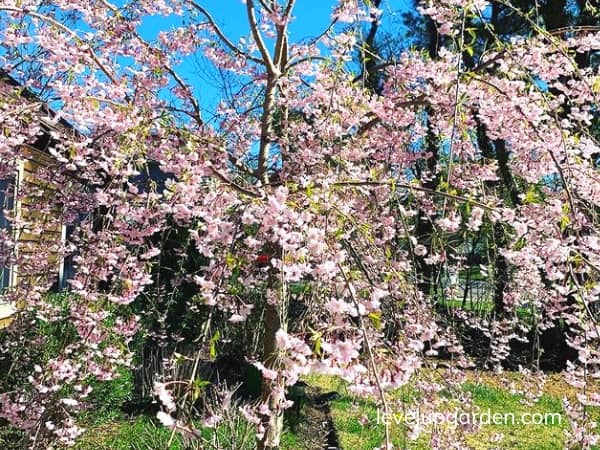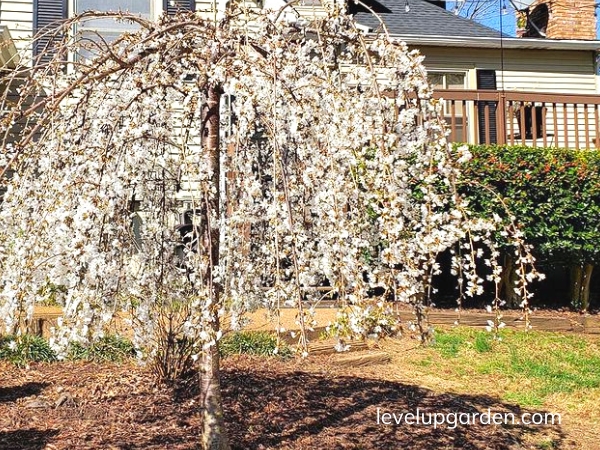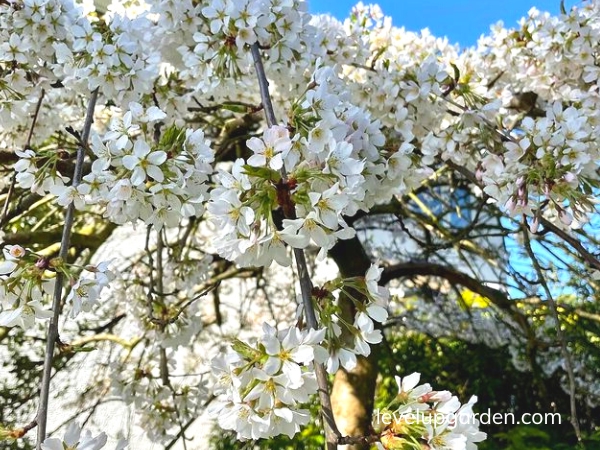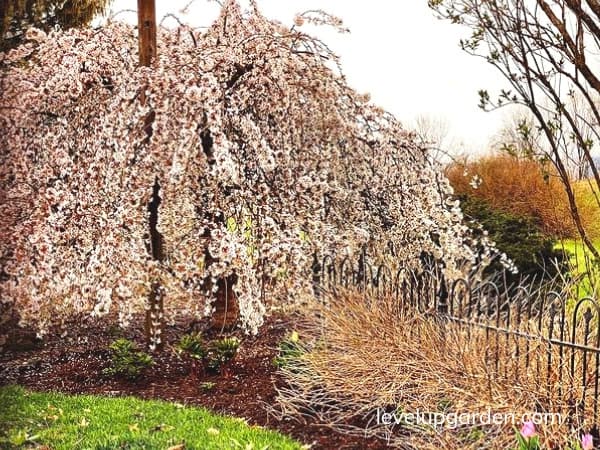The Dwarf Weeping Cherry Tree offers an exceptional choice for those with limited space, as these compact beauties typically grow to a height of 8 to 12 feet. In certain cases, with exceptional care, they may even stretch to an impressive 15 feet. As a relatively new addition to the world of horticulture, these trees have rapidly gained popularity for their remarkable appeal and ease of cultivation.

Drawing comparisons to the weeping mulberry tree, the dwarf weeping cherry gracefully arches toward the ground, creating a stunning visual effect. Enthusiasts adore this tree not only for its generous display of breathtaking white blossoms but also for its low-maintenance nature.
If you happen to come across a Dwarf weeping cherry tree at a nursery, don’t hesitate to make it yours. Touted as the ideal tree for its adaptability to various soils, temperature conditions, and modest size, it’s the perfect addition to any small or medium-sized yard.
I. Plant Profile – An Overview of the Dwarf Weeping Cherry

Dwarf weeping cherry tree species are abundant, offering a multitude of options to choose from, ranging from the compact Hiromi dwarf cherry tree to larger varieties that can grow up to 15 feet or more in height.
| Common Names | Dwarf Weeping Cherry, Snow Fountain, Japanese Dwarf, Hiromi Dwarf |
| Botanical Names | Prunus serrulata, Prunus serrulata ‘Kiku-Shidare-Zakura’, Prunus jacquemontii |
| Growth Habit | Ideal for gardens, yards, parks |
| Hardiness Zones | 5-9 |
| Light | Full sun, minimum 6 hrs of direct light |
| Mature Height | 8-15 ft |
| Mature Witdh | 2-15 ft wide |
| Soil | Light, loamy, well-draining |
| Fertilization | General-purpose fertilizer in early spring |
| Water | 1-3 times/week as needed |
| Bloom Time | Late March – early April |
| Flower Color | Pink, white, or blend |
II. Dwarf Weeping Cherry Trees Appearance
The most striking characteristics of these compact weeping cherry trees are their round and cascading branches, adorned with vibrant pink or white blossoms during springtime. Depending on the specific variety, the blossoms may display an array of colors, including solid white, off-white, yellowish-green, light pink, or vivid pink.

These trees typically range from 8 to 12 feet in height, with some reaching a maximum of 15 feet or slightly taller. If a weeping cherry tree exceeds 15 to 20 feet, it is classified as a semi-dwarf weeping cherry tree rather than a true dwarf.
Blooming usually occurs from late March to early April for these dwarf varieties, though the exact timing depends on factors such as weather, rainfall, winter conditions, and the level of care provided in terms of water, fertilizer, and pruning.
These small cherry trees, with their distinct cascading branches, grow to heights between 6 and 15 feet, boasting a spread of 2 to 15 feet. Among the various cultivars, the Hiromi weeping cherry tree stands the shortest, not exceeding 6 feet in height. In contrast, the Japanese sakura is the tallest dwarf variety, typically growing up to 10 feet, and occasionally a few feet taller. The Snow Fountain weeping cherry tree falls in between, reaching approximately 8 feet in height.
Compared to other weeping cherry trees that can reach up to 25 feet in height, these dwarf varieties offer a much more compact alternative.
III. Growing and Care Conditions
Cultivating a dwarf weeping cherry tree allows for flexibility in its maintenance, as you can choose to let it grow freely or prune it to your preference. If left unpruned, the branches will cascade to the ground, providing a cozy spot for a hammock and a nap. With a lifespan of around 70 years, these trees can mature to heights of 20 to 30 feet. To avoid potential root issues, avoid planting too close to your home.

These trees thrive best in locations receiving six to eight hours of direct sunlight daily. When planting, dig a hole twice the size of the rootball, and use a pitchfork to create holes at the bottom for root growth. Place the rootball in the hole and backfill with a mixture of original soil and peat moss. Water thoroughly, allowing the water to penetrate deeply before watering again. Firmly press the soil to eliminate air pockets and mulch the area to retain moisture and prevent weed growth. In the following sections, we will delve deeper into the specific care requirements for these stunning trees.
Planting
Position the tree’s rootball in the center of the hole, and gently uncurl and spread the roots in all directions. As you backfill the hole, add fresh organic compost to cover the entire rootball, if possible. Once the hole is filled, lightly press down around the tree’s base to compact the soil, and add more backfill or compost if needed.
Spacing
Depending on the weeping dwarf cherry tree species and their eventual size, the suggested spacing ranges from 6 to 15 feet. Proper spacing ensures that the trees receive adequate light and airflow from all angles.
Light
Although dwarf weeping cherry trees can survive with just six hours of direct light per day, they thrive in full-light conditions. This underscores the importance of proper spacing during planting.
Watering
Newly planted trees will be thirsty, so water them as needed—typically every three days, unless there’s ample rainfall. Use fertilizer spikes for the first year, then switch to a time-released fertilizer. After planting, water daily for the first 5 to 10 days, then once every 2 or 3 days for another 5 to 10 days. After the first 3 or 4 weeks, reduce watering to just once a week or as needed to prevent the soil from drying out completely.
Fertilizer
Apply fertilizer to ensure the tree receives proper nutrients for healthy growth.
Soil Requirement
Light, loamy, and well-draining soil is best for dwarf weeping cherry trees. Enriching the soil with organic compost amendments ensures that it’s nutritious and acidic enough for the trees to flourish.
Temperature
These trees can adapt to a variety of temperature conditions. However, it’s essential to monitor and provide appropriate care based on your specific climate.

Pruning
Regular pruning is crucial to maintain the tree’s health and protect it from bacterial blight, brown rot, and other diseases, while also preserving its attractive shape. Remove upward-pointing branches and thin the crown by eliminating crossing or rubbing branches, as well as any growth touching the ground. To maintain symmetry, pinch off lateral growth or “suckers” from the trunk as they appear, preventing the tree from becoming lopsided or top-heavy.
Pests and Diseases
In this section, we will discuss common problems associated with dwarf weeping cherry trees and their solutions. Fortunately, these trees face fewer serious issues than most fruit-bearing trees. However, there are still some concerns to be aware of:
- Aphids and Japanese Beetles:
These pests can cause significant damage to your tree’s branches and trunk. If detected early, remove the affected branches and burn them, and apply organic pest control methods such as cinnamon, lemon juice, or ladybugs. In cases of infestation, insecticides may be necessary.
- Spider Mites and Caterpillars
Both types of pests can severely harm your cherry trees, treating them as an all-you-can-eat buffet. If spotted early, spider mites and caterpillars can be removed by hand. For infestations, pesticides may be necessary.
- Cherry Leaf Spot
This fungal disease can slow down the tree’s overall growth rate and diminish its appearance. Remove and destroy the leaves with spots to prevent contamination, and apply fungicide to the tree’s remaining leaves.
- Powdery Mildew
This fungal disease affects the foliage, and if left unchecked, can cover the entire tree in mold, negatively impacting its appearance. Remove parts of the tree affected by mildew and apply fungicide to the rest of the tree to prevent further spread of the infection.
Propagation
Propagating common dwarf weeping cherry trees is often achieved using fresh cuttings taken during springtime. This method allows gardeners to grow new trees with the same characteristics as the parent tree. To ensure successful propagation, follow these steps:
Choosing Cuttings: Select healthy, disease-free branches from the parent tree. Ideally, choose branches with new growth, as these have a higher likelihood of rooting successfully.
Cutting Technique: Using a sharp, sterilized pair of pruning shears, make a 45-degree angled cut horizontally to remove a 6 to 8-inch section of the branch. The angled cut increases the surface area for better rooting and helps prevent water from pooling on the cut end, reducing the risk of rot.
Preparing the Cutting: Remove the leaves from the lower half of the cutting, leaving only a few leaves at the top to help with photosynthesis. This also reduces water loss through transpiration, allowing the cutting to focus on rooting.
Rooting Hormone: Dip the cut end of the stem in rooting hormone or cinnamon, which can stimulate root growth and protect the cutting from fungal infections. Rooting hormone is available in powder, liquid, or gel form, and can be found at most gardening supply stores.
Planting the Cutting: Prepare a container or growing pod filled with a well-draining, sterile potting mix that includes organic compost and soil. Make a hole in the mix with a pencil or your finger, and insert the cutting into the hole, ensuring that the cut end is well-covered. Gently firm the soil around the cutting to provide support.
Maintaining Moisture: Water the cutting thoroughly and keep the soil consistently moist but not waterlogged. To create a humid environment, cover the container with a clear plastic bag or a plastic dome, but ensure there’s some air circulation to prevent mold growth.
Root Development: Place the container in a warm, bright location, but avoid direct sunlight, which can cause the cutting to dry out. It may take several weeks for roots to develop, so be patient and continue to provide proper care.
Transplanting: Once the cutting has established a healthy root system, it can be transplanted into a larger container or its final location in the garden. Acclimate the young tree gradually to outdoor conditions before planting it in the ground.
Dwarf Weeping Cherry Varieties
Choosing the right dwarf weeping cherry tree variety is crucial to ensure it fits your landscape and personal preferences. Here are some popular and well-known dwarf weeping cherry tree varieties to consider:
Snow Fountain Dwarf Weeping Cherry Tree (Prunus serrulata ‘Snow Fountain’): This stunning variety produces an abundance of pure white blossoms that create a beautiful, cascading effect. The Snow Fountain reaches heights of 10 to 15 feet, making it suitable for small gardens or as a focal point in larger landscapes.

Japanese Dwarf Weeping Cherry Tree (Prunus serrulata ‘Kiku-Shidare-Zakura’): This variety, also known as the ‘Cheal’s Weeping Cherry,’ features double-ruffled pink flowers that create a dramatic display during spring. Like the Snow Fountain, the Japanese Dwarf Weeping Cherry Tree reaches heights of 10 to 15 feet and works well as a focal point or a statement piece in your garden.
Hiromi Dwarf Weeping Cherry Tree (Prunus jacquemontii ‘Hiromi’): The Hiromi is a truly compact variety, often reaching heights of just 3 to 6 feet. This makes it an excellent choice for container gardening or small spaces. The Hiromi produces dainty pink flowers, adding a touch of elegance and charm to your outdoor space.
Each of these dwarf weeping cherry tree varieties offers distinct characteristics, allowing you to choose the perfect fit for your garden’s design and your personal preferences. Whether you opt for the classic white blossoms of the Snow Fountain or the captivating pink flowers of the Japanese or Hiromi varieties, these trees will undoubtedly enhance the beauty of your landscape.
IV. Dwarf Weeping Cherry Tree Uses
Dwarf weeping cherry trees are grown predominantly for their ornamental value and the aesthetic appeal they bring to gardens and landscapes. Their unique weeping shape, combined with their stunning spring blossoms, make them an ideal choice for adding a touch of beauty to any outdoor space. Because of their compact size, they are especially well-suited for smaller gardens, courtyards, or patios, where they can create an eye-catching visual centerpiece without taking up too much space.

In addition to serving as a focal point, dwarf weeping cherry trees can also be planted along property borders to create natural boundaries or used to line pathways, adding charm and visual interest to your outdoor space. Their cascading branches offer a sense of privacy, but they won’t block out light like larger trees might.
If you have limited outdoor space, dwarf weeping cherry trees can even be grown in large containers, making them an excellent choice for balconies or terraces. This approach to planting allows you to elevate the tree, drawing attention to its beautiful form and blossoms.
While the fruit produced by these trees is generally not edible for humans, the flowers are known to attract pollinators, such as bees and butterflies, while the small cherries can provide a food source for birds. By planting a dwarf weeping cherry tree, you’ll be contributing to a diverse and healthy garden ecosystem.
The seasonal interest that these trees offer extends beyond their spring blossoms. In summer, their foliage provides an attractive backdrop in your garden, and in fall, their leaves turn to vibrant shades of red, orange, or gold. With their year-round visual appeal, dwarf weeping cherry trees are an excellent addition to any garden or landscape, providing beauty and charm throughout the seasons.
V. Why you should buy a Dwarf Weeping Cherry Tree
Dwarf weeping cherry trees are an exceptional addition to any garden, thanks to their unique drooping branches and vibrant spring blossoms. These small deciduous trees, with their soft and flexible branches, create a captivating weeping appearance that draws attention and admiration. With proper pruning, most weeping cherry trees can be maintained at a height of less than 15 ft. (4.5 m), making them an excellent choice for small gardens, where space may be limited.

One of the most striking features of these dwarf weeping cherry blossom trees is their remarkable spring blossoms, which come in shades of pink and white with a minimum of five petals. These blossoms not only add a visual appeal but also attract bees and butterflies, enhancing the overall biodiversity of your garden. Among these trees, the Japanese cherry tree ‘Kiku-Shidare-Zakura’ or sakura stands out with its large, ruffled pink blossoms that resemble powder puffs.
Although dwarf weeping cherry trees produce small, sour fruit, they are generally not considered edible for humans. However, these cherries do attract birds, promoting an even more diverse ecosystem within your garden.
Once the blossoms have fallen, dwarf weeping cherry trees develop glossy green lanceolate leaves that contribute to the tree’s overall aesthetic appeal. During the fall season, these leaves transform into vibrant shades of red, orange, or gold, adding another layer of visual interest to your garden before they fall off the tree. In conclusion, incorporating a dwarf weeping cherry tree into your garden not only enhances its beauty but also supports a thriving ecosystem, making it a truly valuable addition.
VI. FAQs
How often should I water my dwarf weeping cherry tree?
For the first 5 to 10 days after planting, water your dwarf weeping cherry tree daily. Then, reduce the watering frequency to once every 2 or 3 days for another 5 to 10 days. After the first 3 or 4 weeks, water the tree once a week or as needed to keep the soil from drying out completely.
When is the best time to prune a dwarf weeping cherry tree?
The best time to prune your dwarf weeping cherry tree is in late winter or early spring, just before new growth begins. This allows you to remove any dead, damaged, or diseased branches, as well as maintain the tree’s attractive shape and prevent any branches from growing upwards.
Can I grow a dwarf weeping cherry tree in a container?
Yes, dwarf weeping cherry trees can be grown in containers, making them ideal for small spaces or patios. Choose a container that is large enough to accommodate the tree’s root system and has proper drainage holes. Be sure to use a high-quality, well-draining potting mix and monitor the tree’s watering needs more closely, as container-grown plants typically require more frequent watering.
Are dwarf weeping cherry trees susceptible to any pests or diseases?
Dwarf weeping cherry trees can be affected by several pests and diseases, including aphids, Japanese beetles, spider mites, caterpillars, cherry leaf spot, and powdery mildew. Regular inspection, proper care, and early intervention with organic pest control or fungicides can help minimize the risk and impact of these issues on your tree’s health and appearance.